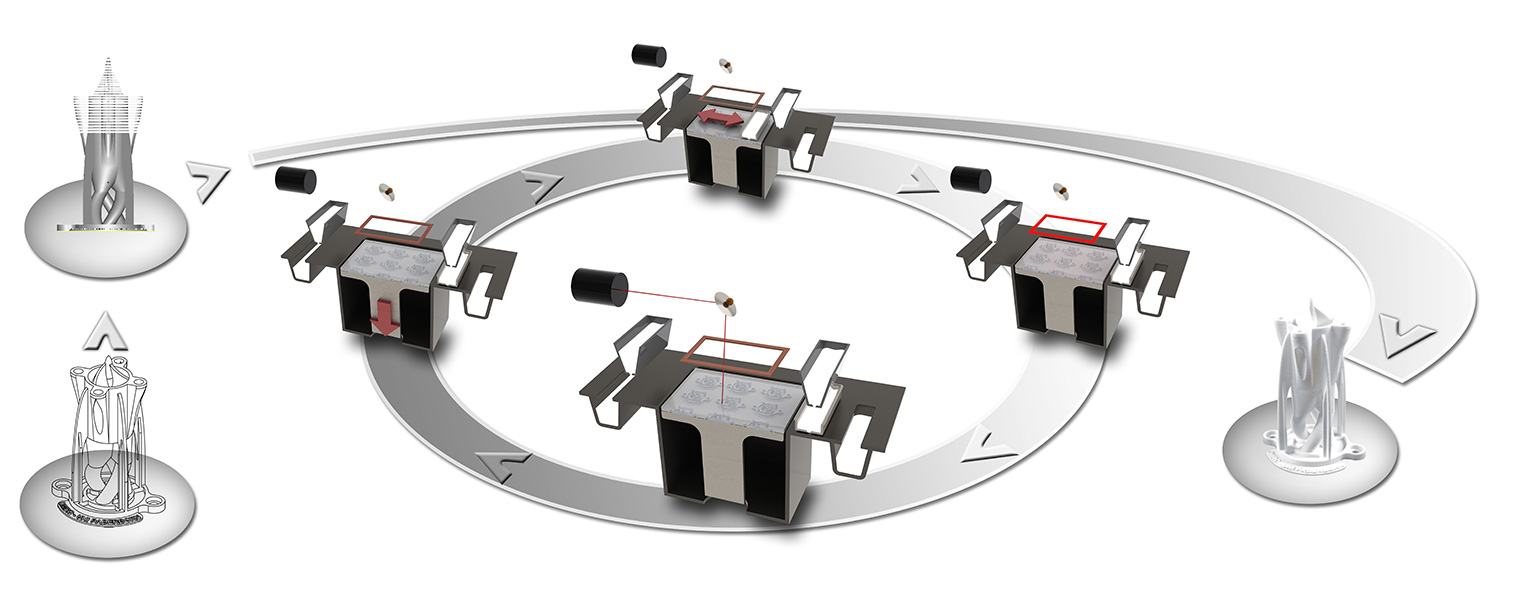Lasersintern
Laser Sintering
Laser Sintering (LS) is an AM-process for the layer-wise creation of parts from powder material without the need of a tool. The manufacturing process is supplied directly from the electronic data (CAD file). Using this process, it is possible to create highly complex and individual geometries in a flexible and cost-effective way.
Via LS, three dimensional objects of any shape can be built without restrictions on forming tools. Parts can have integrated functions like moving elements or inner structures. Ideal applications for LS are highly complex parts in low-volume production. LS technology is used for manufacturing prototypes, models and end-use products. Due to the variety of materials, the method is predestined to be used in the tooling industry, aerospace industry, automotive industry, architecture, and in the consumer goods industry.
Principle of Layer Generation
LS machines lay down a thin layer (60 to 180 μm) of plastic powder via blades or a rotating roller. The whole building chamber is heated up close to the melting temperature of the used material. With a CO2 laser, the powder is locally liquefied at the cross-section of the model, a new load of powder is applied on top and the process repeats. As LS requires a precise temperature control, the scanning strategy and laser energy-input have to be carefully controlled throughout the process.
Build Chamber Volume
The most LS machines are developed and fabricated by EOS GmbH and 3D Systems, Inc. Both companies have several machine types in their portfolio. The build chamber volume depends on the size of the machine. The smallest LS machine has a chamber volume of 200x250x330 mm³ (x/y/z). Bigger parts can be build inside a chamber volume up to 550x550x750 mm³.
Build Time and Build-up Rate
The build time depends on the part size, its orientation inside the building chamber and the machine itself. Furthermore, machines usually offer different operating modes with different layer thicknesses and scanning parameters, which have big influences on the build-up rate as well. In most cases, it is possible to build parts with a speed of approximately 20 mm/h build height.
Material
In general, plastic, metal and sand powders can be used in the LS process. For processable metal materials see the characteristics of “Selective Laser Melting”. The common plastic powders market is dominated by polyamide material, where PA12 is clearly more used than PA11. Variants of PA12 consist of blends with other types of materials. These materials are custom-made polymers that suit the industrial demand in different fields requiring specific properties, e.g. fire or acid resistance. High-performance polymers for the LS process, e.g. PEEK HP3 (based on Polyaryletherketone – PAEK), are suitable for applications that require excellent high temperature performance, wear and chemical resistance etc. Furthermore, materials on the basis of TPE or TPU are available for applications, where a flexible behavior of the material is required.
Post-Processing
The parts cool down slowly due to the high temperatures during the production process and the low heat conductivity of the bulk powder. The remaining powder surrounding the models needs to be removed, which can be done in an unpacking station, where the powder can be sieved as well. The used powder will then be recycled by mixing it with virgin powder. To ensure a constant powder quality, methods to specify the powder age are required. The models, which still have loose adhered powder on their surfaces after unpacking, will be compressed air and glass bead blasted to get their final appearance.

